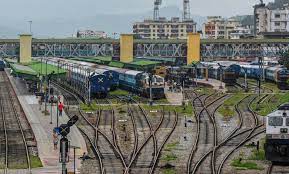Railways to complete electrification of broad gauge routes this year!
By M.Y.Siddiqui
Indian Railways will complete hundred percent electrification of its entire Broad Gauge (BG) routes by the end of this calendar year (2023). Out of a total of 65,269 BG Route Kilo Metres (RKMs) across the country, 58,812 RKMs, equivalent to 90.06 per cent RKMs have been completed as on March 31, 2023. Remaining 6,457 BG RKMs will be completed by December 31, 2023. Work of electrification is going on with full force. Allocation of Rs. 8,070 crore has been provided in the union budget 2023-24 in the Ministry of Railways for completion of electrification, in any case, by March 31, 2024.
With that the entire BG RKMs will be electrified ensuring high-speed environment friendly, cost effective bulk rail services to the nation. Electric traction is seven times environmental friendly and cheaper than coal and six times economical than diesel. However, some percentage of diesel locomotives will still be needed to meet contingency of snapping of power cables, breakdown of AC locomotives and for shunting yards.
Railways electrified 37,011 RKMs over the last nine years, which is record breaking compared to 21,413 RKMs of railway tracks before 2014. This is intended to provide seamless fast rail services to the nation. According to Ministry of Railways, around 50 per cent of the total RKMs electrified have been completed in the last five years. Railways have completed hundred percent electrification in 14 States and Union Territories, considered significant steps to make train operation sustainable, cost effective and eco-friendly.
In a policy decision, Ministry of Railways has decided to make Indian Railways the world’s largest green railways with zero carbon emission by 2030. To accomplish this, all new railway lines to be sanctioned and constructed, henceforth, will also continue to be electrified simultaneously. Electrification of tracks has been prioritized to reduce country’s dependence on costlier imported petroleum products like diesel in order to make rail services energy efficient, economical, faster and environmental friendly bulk transportation of passengers and goods to accelerate all round development of the nation. In a landmark development, official sources have revealed that Indian Railways have take up trial of hydrogen based fuel technology to make rail services still the most environment friendly and more economical.
Railway electrification work has been made a joint work by Rail Vikas Nigam Limited (RVNL), Central Organisation for Railway Electrification (CORE), Power Grid Corporation, and Rail India Technical and Economic Services Ltd. (RITES) to fast pace electrification work. Earlier, rail electrification used to be the sole work of the CORE. Combination of four entities of repute has helped accelerate rail electrification work.
Earlier, electrical wing in Ministry of Railways used to be a poor cousin of departments of civil and mechanical engineering. Electrical wing used to be looked down upon with derision by the so-called mechanical engineering department. With growing concern for environment denudation and official measures to stem it, Rajiv Gandhi Union Government created a full-fledged electrical engineering department in Ministry of Railways with a full Member Electrical and ex-officio Secretary to the Government of India as its head. The first Member Electrical was Sandeep Kumar Khanna, son of the legendary Justice Hans Raj Khanna of the Supreme Court of India, who dissented in the Constitution Bench upholding the Emergency, by stating that Constitution or no Constitution, Law or no Law, a person derives his/her inherent fundamental rights to life and liberty right from his/her birth and no power much less a government can take away that rights. He quashed suspension of fundamental rights during Emergency thereby immortalized himself as the best judge of the apex court, so far.
With S.K.Khanna at the helm, electrification of rail track was prioritized with a dedicated supervisory control. But resource crunch made it still slow. With globalization of Indian economy set in motion in July 1991, rail electrification was further prioritized over and above the dominant mechanical engineering department and more and more money was allocated for rail electrification. The current Union Government accelerated electrification of railway tracks further as part of its infrastructural push as never before to meet environmental friendly requirements of the globalized world!
Powered by Froala Editor




LEAVE A REPLY